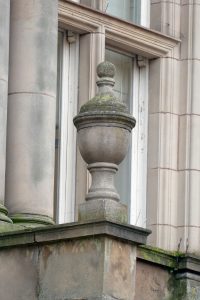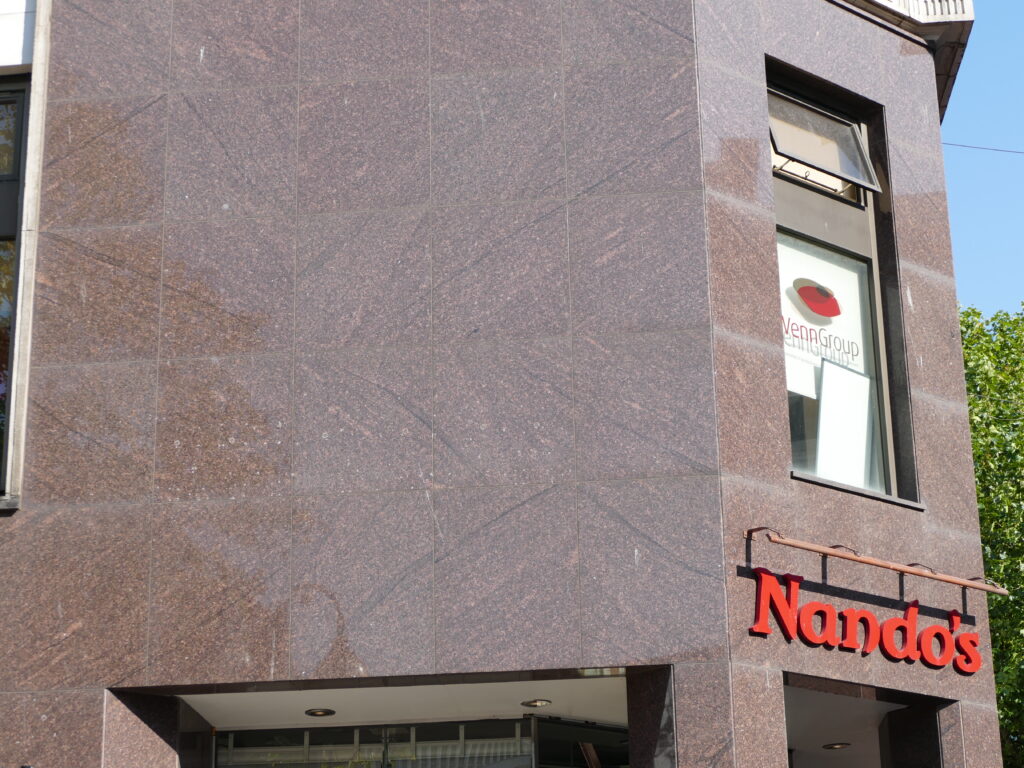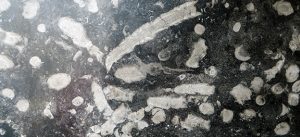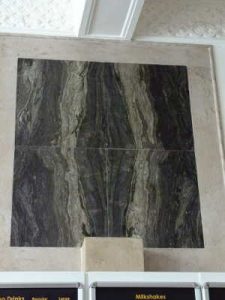Birmingham Building Stones Trails
Trail 1: From the Town Hall to the Cathedral continued
Retrace your steps past the Museum and Art gallery, to the front of the Council House. As you go, note the variety of features in the sandstone blocks. There is some grading in the coarseness of the sandstone, and much evidence of cross-bedding. The discerning eye might note that some of the cross-bedded blocks are upside down. Below the Council House, the sloping Victoria Square has been landscaped and features fountains and sculpture.
4. Victoria Square
The landscaping and sculptures in Victoria square are the creation of sculptor Dhruva Mistry and were installed between 1992 and 1994. Four pieces of art come together in this installation, which are entitled ‘The River’, ‘Guardians’, ‘Youth’ and ‘Object (Variations)’. The pools and their rims associated with the sculptures ‘The River’ and ‘Youth’ are in Watts Cliffe Sandstone, as are very possibly, the stone balls around the higher end of the square. Watts Cliffe stone is extracted from Elton in Derbyshire and is a unit of the Upper Carboniferous Millstone Grit Group. It was supplied for this project by the quarry owners, Realstone.
Darley Dale Sandstone is used for ‘The Guardians’ and the symbolic building forms ‘Object (Variations)’; this stone was chosen in keeping with the Council House above. The finely honed finish on the Guardians and the fantastical building-like obelisks reveal the composition and textures of this grit stone; yellowish-brown in colour, it is composed of sub-rounded quartz grains.
Walk down towards Victoria Square House, on the corner with Pinfold Street. Look back at the Council House as you go, to appreciate the scale of the building and the contrasting effect of the Portland Stone pediments.
5. Victoria Square House
At the lower end of Victoria Square is Victoria Square House, another building in Upper Carboniferous sandstone, again quite possibly one of the building stones from the Millstone Grit. It was built as Birmingham’s head post office but was a disliked building and described at the time of its completion in 1891 as ‘coarse and commonplace’, ornamented with ‘pots and tea-urns’ in The Builder magazine. The responsible architect was Sir Henry Tanner. This again is built from a quartz-rich, fine-medium grained stone, but with flecks of white mica which reflect the light. Around the doorway are columns of grey granite and this stone is also used for the soffits of the main doorway. The ‘tea-urns’ are above the door on Victoria Square. The exact provenance of this stone is unknown, but this is possibly Bessbrook Granite, a Late Caledonian granite from the Newry Granodiorite complex in County Armagh, Ireland. The larger crystals are plagioclase, and the groundmass is plagioclase, microcline, quartz biotite and hornblende.
From Victoria Square, cross the pedestrianized end of New Street to Waterloo House, filling the block between New Street and Waterloo Street.
6. Waterloo House
Waterloo House is situated along the east side of the square on the corner with New Street. The original building dates from the 1920s, but the granite cladding which we will now examine was added in the 1970s. The lower floor (now a Nando’s restaurant, 2021) has an entrance on New Street and has been clad in relatively recent times with a dark red granite called Dakota Mahogany. This is an ancient stone, 2.7Ga. It is quarried in Millbank, South Dakota in the USA. This stone has been quarried since the 1920s but has become a globally important building stone since the 1950s and it is commonly seen as cladding on many modern office blocks and shop fronts throughout the world. The orange-red colour is imparted by potassic feldspars which have a perthitic texture, but looking closely, there is also grey blue, opalescent quartz and the black minerals are biotite and hornblende. Up the steps alongside the building, the entrance to Waterloo House on Waterloo Street is also paved with an ancient stone, but a youngster compared to Dakota Mahogany. This is a variety of 1.5Ga Rapakivi Granite called by geologists wiborgite and by stone marketeers as Baltic Brown. Texturally it contains distinctive ‘ovoids’ of pink potassic feldspar, rimmed by green plagioclase. The groundmass is of dark brown smoky quartz, hornblende and biotite. Like Dakota Mahogany, Baltic Brown is one of the world’s most recognisable building stones. It is quarried in eastern Finland, close to the border with Russia. The huge Vyborg Batholith, in which there are many quarries for this stone, straddles the border.
Next door along Waterloo Street is New Oxford House.
7. New Oxford House
New Oxford House comprises an entrance to the office block between Pieminister and Adam’s restaurants. This is an Art Deco building completed in 1936 by the architect S. N. Cooke (who had also co-designed the Hall of Memory in Centenary Square). The entrance to the offices on the upper storeys is flanked with two stone door jambs with unusual carvings of heads. These are by the sculptor William Bloye.
Portland Stone, the variety known as Whitbed (also seen at Stop 2 on this trail), is the main building stone used here; it is distinguished from the Derbyshire stone by the absence of crinoids and the presence of oyster shells. These weather out slightly from the pale grey, oolitic limestone matrix. Portland Stone is uppermost Jurassic in age (c.150Ma) and quarried from opencast and underground quarries on the Isle of Portland in Dorset.
Crystallographically these are larger than their precursor and therefore serpentinisation is accompanied by a volumetric expansion of the rocks – hence the brecciation. Water is important in this process causing changes to the crystal structure, and serpentinisation occurs typically in ultra-mafic rocks. The white veins that formed at this time are infilled with calcite. Looking at the contiguous blocks of serpentinite, they can be seen to be studded with crystals around 5mm diameter. These are ‘bastites’, pseudomorphs after pyroxene has been replaced by talc and tremolite. They have a slightly bronzy appearance. The presence of bastite tells us that this serpentinite represents the upper ‘igneous’ section of oceanic lithosphere. The slightly reddened appearance of some of these slabs is the consequence of oxidation, indicating that this serpentinite was perhaps exposed on the seafloor prior to obduction.
Return to Victoria Square and walk up (right) and then turn right onto Colmore Row. The first building of note is on the south side and is currently a coffee shop which may make a welcome pit stop on this walk.
8. Java Lounge Coffee Shop, 122-124 Colmore Row
Walk 1 continues on the next page…
References can be found on the last page of the walk (1.4).









